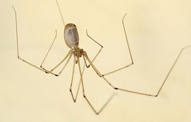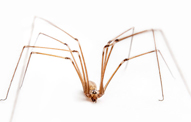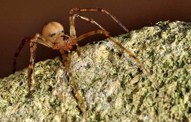How to Identify Cellar Spiders
Often mistaken for other spider species, cellar spiders are commonly called daddy longlegs spiders, granddaddy longlegs spiders, carpenter spiders or vibrating spiders. Confusion arises due to applying the name "daddy longlegs" to two distantly related arthropod groups: harvestmen, which are arachnids but not spiders, and crane flies, which are insects.
Cellar spiders hang upside-down in messy, irregular, tangled webs. Preferring the dark, damp recesses of caves, under rocks, under loose bark, abandoned mammal burrows, in addition to undisturbed areas such as cellars and basements, cellar spiders also spin their webs in warm, dry windows and attics.
Cellar Spider Behavior
Although cellar spider webs don’t contain adhesive properties, their random web structure traps insects, making their escapes difficult. After snaring prey, cellar spiders quickly envelop their prey with silk then inflict fatal bites. Cellar spiders may eat prey immediately or store their catches for later.
When cellar spiders’ webs are disturbed or these spiders are threatened by entangled, large preys, these arachnids initiate rapidly vibrating, gyrating motions in their webs, blurring themselves, making it difficult to focus on them. This erratic behavior earned these spiders the name, "vibrating spiders," although they are not the only species to exhibit this behavior.
Some cellar spider species raid other spiders’ webs and eat the hosts, their eggs or the other spiders’ prey. Clever cellar spiders have been known to vibrate other spiders’ webs, mimicking trapped prey to lure the hosts into their devious traps, including huntsman spiders and poisonous hobo spiders.



